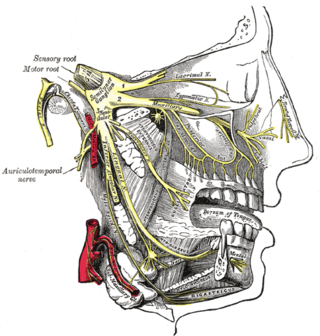Top Qs
Timeline
Chat
Perspective
Trigeminal ganglion
Sensory ganglion of the trigeminal nerve From Wikipedia, the free encyclopedia
Remove ads
The trigeminal ganglion (also known as: Gasserian ganglion, semilunar ganglion, or Gasser's ganglion) is the sensory ganglion of each trigeminal nerve (CN V). The trigeminal ganglion is located within the trigeminal cave (Meckel's cave), a cavity formed by dura mater.
Remove ads
Anatomy
Summarize
Perspective
The trigeminal ganglion contains cell bodies of the pseudo-unipolar sensory neurons of the trigeminal nerve which extend their axons both distally/peripherally into the three divisions of the trigeminal nerve on the one end, and proximally/centrally to the brainstem on the other end; the trigeminal root extends from the trigeminal ganglion to the ventrolateral aspect of the pons.[1]
The trigeminal ganglion is situated within the trigeminal cave (or Meckel's cave), a cerebrospinal fluid-filled cavity formed by a double layer of dura mater overlying[1][2] the trigeminal impression near the apex of the petrous part of the temporal bone.[2]
Structure
The trigeminal ganglion is somewhat crescent-shaped, with its convexity directed anterolaterally. From its convex border arise the ophthalmic nerve (V1), maxillary nerve (V2), and mandibular nerve (V3).[2]
The ganglion receives, on its medial side, filaments from the carotid plexus of the sympathetic. It issues minute branches to the tentorium cerebelli, and the dura mater in the middle cranial fossa.[citation needed]
Relations
Medially to the trigeminal ganglion are the internal carotid artery, and the posterior part of the cavernous sinus.[2]
The motor root of the trigeminal nerve passes beneath the trigeminal ganglion to exit the skull through the foramen ovale.[2] The greater petrosal nerve passes underneath the trigeminal ganglion to reach the foramen lacerum.[3]: 498, 509
Remove ads
Clinical significance
Herpes virus dormancy
After recovery from a primary herpes infection, the virus is not cleared from the body, but rather lies dormant in a non-replicating state within the trigeminal ganglion.[4]
Lesions
If the trigeminal ganglion is damaged, by infection or surgery, it gives rise to the trigeminal trophic syndrome, which involves paresthesias and anesthesia, and may lead to erosions of the nasal ala.[citation needed]
Ablation in trigeminal neuralgia
The thermocoagulation or injection of glycerol into the trigeminal ganglion has been used in the treatment of trigeminal neuralgia.[citation needed]
Remove ads
Other animals
Rodents
In rodents, the trigeminal ganglion is important as it is the first part of the pathway from the whiskers to the brain. Cell bodies of the whisker primary afferents are found here. These afferents are mechanoreceptor cells that fire in response to whisker deflection.[citation needed]
There are around 26,000–43,000 cell bodies in rodent trigeminal ganglion. It is possible that there are two distinct (or perhaps continuous) populations of cells having slowly and rapidly adapting responses to stimuli.[citation needed]
It is found at the base of the skull and projects to trigeminal brain stem areas including principalis, spinal trigeminal nucleus, interpolaris, and caudalis.[citation needed]
Additional images
- Base of the skull. Upper surface.
- Nerves of the orbit, and the ciliary ganglion. Side view.
- The otic ganglion and its branches.
- Trigeminal ganglion
- Trigeminal ganglion. Deep dissection. Superior view.
References
External links
Wikiwand - on
Seamless Wikipedia browsing. On steroids.
Remove ads







